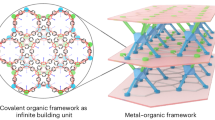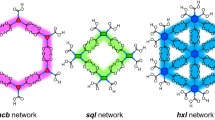Abstract
The rational design and synthesis of ultramicroporous solids featuring uniform pore dimensions remains a notable challenge, yet these materials are critical for the selective discrimination of molecules with similar physicochemical properties. Here we report a family of ten ultramicroporous zirconium-based metal–organic frameworks assembled from isophthalate-based octatopic or hexatopic carboxylate linkers with high coordination density and Zr6 nodes with relatively low connectivity (4, 6 and 8). The diverse inorganic node geometry, ligand connectivity, structural topology, framework stability and ultramicroporosity of the resultant metal–organic frameworks underscore the pivotal role of linker geometry and functionality in tailoring the adsorptive properties of the material. These ultramicroporous solids hold promise for the separation of industrially relevant hydrocarbons. We show that HIAM-802 and HIAM-601 exhibit high-efficiency separation of hexane isomers based on branching by molecular exclusion. We validated their separation capabilities through breakthrough experiments and further clarified the underlying adsorption mechanisms by density functional theory calculations.

This is a preview of subscription content, access via your institution
Access options
Access Nature and 54 other Nature Portfolio journals
Get Nature+, our best-value online-access subscription
$32.99 / 30 days
cancel any time
Subscribe to this journal
Receive 12 print issues and online access
$259.00 per year
only $21.58 per issue
Buy this article
- Purchase on SpringerLink
- Instant access to full article PDF
Prices may be subject to local taxes which are calculated during checkout





Similar content being viewed by others
Data availability
All data involved in this work are included in this article and the corresponding supplementary materials. The crystallographic data for the structures reported in this article have been deposited at the Cambridge Crystallographic Data Centre, under deposition numbers CCDC 2351913 (HIAM-801), 2351914 (HIAM-802), 2351915 (HIAM-803), 2351916 (HIAM-804), 2351917 (HIAM-805), 2351918 (HIAM-806), 2351919 (HIAM-601), 2351920 (HIAM-602), 2351921 (HIAM-603) and 2351922 (HIAM-604). Copies of the data can be obtained free of charge via https://www.ccdc.cam.ac.uk/structures/. Source data are provided with this paper.
References
Bennett, T. D., Coudert, F.-X., James, S. L. & Cooper, A. I. The changing state of porous materials. Nat. Mater. 20, 1179–1187 (2021).
Li, Y. & Yu, J. Emerging applications of zeolites in catalysis, separation and host–guest assembly. Nat. Rev. Mater. 6, 1156–1174 (2021).
Zeng, H. et al. Orthogonal-array dynamic molecular sieving of propylene/propane mixtures. Nature 595, 542–548 (2021).
Shao, W. et al. Engineering ultramicroporous carbon with abundant C═O as extended ‘slope-dominated’ sodium ion battery anodes. ACS Sustainable Chem. Eng. 9, 9727–9739 (2021).
Sholl, D. S. & Lively, R. P. Seven chemical separations to change the world. Nature 532, 435–437 (2016).
Du, S. et al. Probing sub-5 Ångstrom micropores in carbon for precise light olefin/paraffin separation. Nat. Commun. 14, 1197 (2023).
Liu, T. & Liu, G. Porous organic materials offer vast future opportunities. Nat. Commun. 11, 4984 (2020).
Zhou, C. et al. Hybrid organic–inorganic two-dimensional metal carbide MXenes with amido- and imido-terminated surfaces. Nat. Chem. 15, 1722–1729 (2023).
Gao, Y. et al. Molecular engineering of organic–inorganic hybrid perovskites quantum wells. Nat. Chem. 11, 1151–1157 (2019).
Jiang, H., Alezi, D. & Eddaoudi, M. A reticular chemistry guide for the design of periodic solids. Nat. Rev. Mater. 6, 466–487 (2021).
Furukawa, H., Cordova, K. E., O’Keeffe, M. & Yaghi, O. M. The chemistry and applications of metal–organic frameworks. Science 341, 1230444 (2013).
Li, L. et al. Ethane/ethylene separation in a metal–organic framework with iron-peroxo sites. Science 362, 443–446 (2018).
Kim, H. et al. Water harvesting from air with metal–organic frameworks powered by natural sunlight. Science 356, 430–434 (2017).
Mondloch, J. E. et al. Destruction of chemical warfare agents using metal–organic frameworks. Nat. Mater. 14, 512–516 (2015).
Lin, R.-B. et al. Molecular sieving of ethylene from ethane using a rigid metal–organic framework. Nat. Mater. 17, 1128–1133 (2018).
Wang, B., Côté, A. P., Furukawa, H., O’Keeffe, M. & Yaghi, O. M. Colossal cages in zeolitic imidazolate frameworks as selective carbon dioxide reservoirs. Nature 453, 207–211 (2008).
Zhai, Q.-G., Bu, X., Zhao, X., Li, D.-S. & Feng, P. Pore space partition in metal–organic frameworks. Acc. Chem. Res. 50, 407–417 (2017).
Yang, H. et al. Optimization of pore-space-partitioned metal–organic frameworks using the bioisosteric concept. J. Am. Chem. Soc. 144, 20221–20226 (2022).
Zhou, D.-D. et al. Intermediate-sized molecular sieving of styrene from larger and smaller analogues. Nat. Mater. 18, 994–998 (2019).
Lin, Y. et al. Temperature-programmed separation of hexane isomers by a porous calcium chloranilate metal–organic framework. Angew. Chem. Int. Ed. 61, e202214060 (2022).
Li, M., Li, D., O’Keeffe, M. & Yaghi, O. M. Topological analysis of metal–organic frameworks with polytopic linkers and/or multiple building units and the minimal transitivity principle. Chem. Rev. 114, 1343–1370 (2014).
O’Keeffe, M. & Yaghi, O. M. Deconstructing the crystal structures of metal–organic frameworks and related materials into their underlying nets. Chem. Rev. 112, 675–702 (2012).
Saraci, F., Quezada-Novoa, V., Donnarumma, P. R. & Howarth, A. J. Rare-earth metal–organic frameworks: from structure to applications. Chem. Soc. Rev. 49, 7949–7977 (2020).
Guillerm, V. et al. Discovery and introduction of a (3,18)-connected net as an ideal blueprint for the design of metal–organic frameworks. Nat. Chem. 6, 673–680 (2014).
Shi, L., Yang, Z., Sha, F. & Chen, Z. Design, synthesis and applications of functional zirconium-based metal–organic frameworks. Sci. China Chem. 66, 3383–3397 (2023).
Bai, Y. et al. Zr-based metal–organic frameworks: design, synthesis, structure, and applications. Chem. Soc. Rev. 45, 2327–2367 (2016).
Cavka, J. H. et al. A new zirconium inorganic building brick forming metal organic frameworks with exceptional stability. J. Am. Chem. Soc. 130, 13850–13851 (2008).
Hu, Z. & Zhao, D. De facto methodologies toward the synthesis and scale-up production of UiO-66-type metal–organic frameworks and membrane materials. Dalton Trans. 44, 19018–19040 (2015).
Furukawa, H. et al. Water adsorption in porous metal–organic frameworks and related materials. J. Am. Chem. Soc. 136, 4369–4381 (2014).
Bon, V., Senkovska, I., Baburin, I. A. & Kaskel, S. Zr- and Hf-based metal–organic frameworks: tracking down the polymorphism. Cryst. Growth Des. 13, 1231–1237 (2013).
Wang, H. et al. Topologically guided tuning of Zr-MOF pore structures for highly selective separation of C6 alkane isomers. Nat. Commun. 9, 1745 (2018).
Gong, W. et al. Modulator-dependent dynamics synergistically enabled record SO2 uptake in Zr(IV) metal–organic frameworks based on pyrene-cored molecular quadripod ligand. J. Am. Chem. Soc. 145, 26890–26899 (2023).
Liu, W. et al. Reticular synthesis of metal–organic frameworks by 8-connected quadrangular prism ligands for water harvesting. Angew. Chem. Int. Ed. 62, e202305144 (2023).
Alezi, D. et al. Reticular chemistry at its best: directed assembly of hexagonal building units into the awaited metal–organic framework with the intricate polybenzene topology, pbz-MOF. J. Am. Chem. Soc. 138, 12767–12770 (2016).
Wang, S. et al. Engineering structural dynamics of zirconium metal–organic frameworks based on natural C4 linkers. J. Am. Chem. Soc. 141, 17207–17216 (2019).
Leubner, S. et al. Synthesis and exfoliation of a new layered mesoporous Zr-MOF comprising hexa- and dodecanuclear clusters as well as a small organic linker molecule. J. Am. Chem. Soc. 142, 15995–16000 (2020).
Zhang, Y. et al. A flexible metal–organic framework with 4-connected Zr6 nodes. J. Am. Chem. Soc. 140, 11179–11183 (2018).
Wang, Y. et al. Uncovering structural opportunities for zirconium metal–organic frameworks via linker desymmetrization. Adv. Sci. 6, 1901855 (2019).
Lyu, H. et al. Carbon dioxide capture chemistry of amino acid functionalized metal–organic frameworks in humid flue gas. J. Am. Chem. Soc. 144, 2387–2396 (2022).
Feng, D. et al. A highly stable zeotype mesoporous zirconium metal–organic framework with ultralarge pores. Angew. Chem. Int. Ed. 54, 149–154 (2015).
Herm, Z. R. et al. Separation of hexane isomers in a metal–organic framework with triangular channels. Science 340, 960–964 (2013).
Xie, F., Yu, L., Wang, H. & Li, J. Metal–organic frameworks for C6 alkane separation. Angew. Chem. Int. Ed. 62, e202300722 (2023).
Zhang, Z., Peh, S. B., Kang, C., Yu, K. & Zhao, D. Efficient splitting of alkane isomers by a bismuth-based metal–organic framework with auxetic reentrant pore structures. Angew. Chem. Int. Ed. 61, e202211808 (2022).
Yu, L. et al. Splitting mono- and dibranched alkane isomers by a robust aluminum-based metal–organic framework material with optimal pore dimensions. J. Am. Chem. Soc. 142, 6925–6929 (2020).
Grimme, S. Semiempirical GGA-type density functional constructed with a long-range dispersion correction. J. Comput. Chem. 27, 1787–1799 (2006).
Blöchl, P. E. Projector augmented-wave method. Phys. Rev. B 50, 17953–17979 (1994).
Perdew, J. P., Burke, K. & Ernzerhof, M. Generalized gradient approximation made simple. Phys. Rev. Lett. 77, 3865–3868 (1996).
Kresse, G. & Furthmüller, J. Efficiency of ab-initio total energy calculations for metals and semiconductors using a plane-wave basis set. Comp. Mater. Sci. 6, 15–50 (1996).
Jiang, Z.-J. et al. Dehydration-induced cluster consolidation in a metal–organic framework for sieving hexane isomers. Angew. Chem. Int. Ed. 63, e202403209 (2024).
Acknowledgements
The work was supported by the National Natural Science Foundation of China (grant nos. 22478251 to H.W., 22071234 to S.W. and 22178119 to Q.X.), Shenzhen Science and Technology Program (grant no. KCXFZ20211020163818026 to H.W.), the CAS Talent Introduction Program (grant no. KJ9990007009 to S.W.) and the U.S. Department of Energy, Office of Science, Office of Basic Energy Sciences (grant no. DE-SC0019902 to J.L.). Moreover, we thank S. Ullah for helpful discussions.
Author information
Authors and Affiliations
Contributions
S.W., J.L. and H. W. conceived the idea and supervised the project. L.Y., S.L. and X.Z. synthesized the samples and conducted the characterization. L.Y. performed the adsorption measurements and calculations. B.Z. and Q.X. participated with the data analysis. K.Z. performed the crystal structure analysis. L.Y. and H.W. wrote the first draft. S.W. and J.L. revised the paper and all authors participated in the discussion of the results and made comments on the paper.
Corresponding authors
Ethics declarations
Competing interests
The authors declare no competing interests.
Peer review
Peer review information
Nature Chemistry thanks Zongbi Bao, Aziz Ghoufi and the other, anonymous, reviewer(s) for their contribution to the peer review of this work.
Additional information
Publisher’s note Springer Nature remains neutral with regard to jurisdictional claims in published maps and institutional affiliations.
Supplementary information
Supplementary Information
Supplementary Figs. 1–100, Tables 1–15, Notes 1–3 and references.
Supplementary Data 1
Cartesian coordinates for the optimized structures.
Supplementary Data 2
Crystallographic data for HIAM-801 (CCDC 2351913).
Supplementary Data 3
Crystallographic data for HIAM-802 (CCDC 2351914).
Supplementary Data 4
Crystallographic data for HIAM-803 (CCDC 2351915).
Supplementary Data 5
Crystallographic data for HIAM-804 (CCDC 2351916).
Supplementary Data 6
Crystallographic data for HIAM-805 (CCDC 2351917).
Supplementary Data 7
Crystallographic data for HIAM-806 (CCDC 2351918).
Supplementary Data 8
Crystallographic data for HIAM-601 (CCDC 2351919).
Supplementary Data 9
Crystallographic data for HIAM-602 (CCDC 2351920).
Supplementary Data 10
Crystallographic data for HIAM-603 (CCDC 2351921).
Supplementary Data 11
Crystallographic data for HIAM-604 (CCDC 2351922).
Source data
Source Data Fig. 1
Source data of each point in Fig. 1a,b.
Source Data Fig. 4
Source data of the adsorption results in Fig. 4.
Source Data Fig. 5
Source data of the computational results in Fig. 5.
Rights and permissions
Springer Nature or its licensor (e.g. a society or other partner) holds exclusive rights to this article under a publishing agreement with the author(s) or other rightsholder(s); author self-archiving of the accepted manuscript version of this article is solely governed by the terms of such publishing agreement and applicable law.
About this article
Cite this article
Yu, L., Li, S., Zhou, X. et al. Building ultramicroporous zirconium metal‒organic frameworks with ligands of high coordination density through a reticular approach. Nat. Chem. 17, 1207–1215 (2025). https://doi.org/10.1038/s41557-025-01836-6
Received:
Accepted:
Published:
Issue date:
DOI: https://doi.org/10.1038/s41557-025-01836-6



